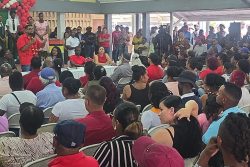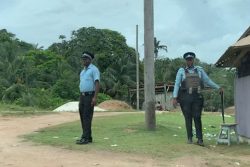Introduction
Under the theme, “Steadfast Against All Challenges, Resolute in Building Our One Guyana,” the 2022 Budget represents the second full-year budget of the PPP/C during the COVID-19 pandemic. The 2022 Policy Issues and Targets are set out in Chapter 4 of the Budget Speech – Sectoral Development and the Agenda for 2022.
Overview
The government credits its policies and targets for the future ultimately to its contract with the People of Guyana – its Party’s 2020 Manifesto -, and to global and regional goals such as the Sustainable Development Goals (SDGs) and CARICOM’s Twenty-Five by 25. For the medium term, the Government’s plan is to make Guyana an economic powerhouse and national prosperity a reality. The Minister also re-emphasised the government’s focus on “strong economic growth” and “fiscal and external sustainability” for the medium and long term respectively,” earned from the oil and gas sector.
Macroeconomic Outlook
Re-emphasising the growth that the Budget proposes, the Minister expressed the government’s focus as the achievement of immediate, national development needs within the context of investing in the future. In this regard, the government proposes the promotion of production, processing and business in agriculture as a major objective. Conscious of reconciling the challenge of climate change with oil production, the Minister identified The Low Carbon Development Strategy (LCDS 2030) as the “overarching” strategy underpinning the country’s fight against climate change. Key actions proposed under the LCDS 2030 are:
1. Integrating Guyana’s forest climate services with emerging global carbon markets;
2. Supporting Guyana’s economic transformation through cleaner, cheaper ener gy;
3. Investing in adaptation to climate change and building resilience; and
4. Contributing to the global effort to address climate change and biodiversity loss.
Diversified, Resilient and Competitive Productive Sector
The Minister announced extensive plans and, as we shall see later, substantial investments in all sectors of the economy, both traditional and emerging.
In Oil and Gas, the Minister spoke of the exploration and production activities in the Stabroek, Payara, Yellowtail, Kaieteur and Canje Blocks. He also announced the strengthening of the legislative framework for the oil and gas sector with the enactment of the Local Content Act which focused on expanding business and job opportunities of Guyanese through forty sectors and services. He also referred to the repeal and replacement of the Natural Resource Fund Act of 2019 by an Act of the same name in 2021.
The Minister reaffirmed the Government’s commitment to investing in the extractive industries, identifying the gold and diamond mining sector and beneficial occupation of sand bearing properties along the Soesdyke-Linden Highway towards the housing and road development projects. The Government’s focus for GuySuCo is towards the production and marketing of more value-added products for both the domestic and international markets.
The Administration has announced that Agriculture will be one of the major anchors of the country’s non-oil economy with a view to providing food security, improving incomes, creating jobs and generating foreign exchange income. The Minister announced that the Guyana Sugar Corporation is set for a “turn around” and the possibility of private investment. In Livestock, the Government proposes private sector partnerships to develop a modular abattoir at Garden of Eden to expand the production of pork and pork products and a modern abattoir in Onverwagt for beef and beef products.
In the areas of Fisheries and Aquaculture, the Minister acknowledges the “challenging times” faced by the industry and committed the Government’s support to the livelihood by fishermen and budgetary allocations for the development of marine cage fishing, and aquaculture and brackish-water shrimp production.
In tourism, the Minister announced the country’s partnership with a number of airlines designed to boost tourism and the construction of eight additional hotels and 685 hotel rooms in 2022 and 2,180 by 2025. In information and communication technology, the Minister drew attention to the liberalisation of the telecommunication sector and returns that have been received due to such sectoral opening. The Minister also spoke to job creation and training opportunities in ICT-related subject areas.
Transformational Infrastructure
The Minister announced as the three areas the Government considers of transformational value, Energy Expansion and Diversification, Transport Infrastructure and Sea and River Defence. Projects identified under Energy Expansion and Diversification are the Amaila Falls Hydro Project, the Gas-to-Energy project power, Kumu hydropower plant project, the GPL build-own-operate-transfer (BOOT) arrangement, and its own investment in solar energy by way of solar farm interventions.
Major projects for Transport infrastructure, for which a budgetary allocation of $76.7 billion is made include:
– the East Bank-East Coast Demerara Road Linkage between Ogle and Eccles
– the rehabilitation of the Corentyne Main Road from Palmyra to Crabwood Creek
– the construction of the Linden-Mabura Hill Road
– hinterland roads
– the rehabilitation of the entire Soesdyke-Linden Highway
– completion of the Sheriff Street – Mandela Road Network Expansion Project.
– for the construction and rehabilitation of additional urban and community roads
– a new four-lane highway linking Mandela Avenue to Haags Bosch and the construction of the four-lane Ogle to Haags Bosch road
– the widening of the East Coast highway from Annandale to Mahaica
– the upgrade of the railway embankment from Sheriff Street to Orange Nassau
– the construction of the new four-lane superhighway from Schoonord to Parika.
Major bridge projects identified by the Minister, are a fixed four-lane high span Demerara River Bridge, rehabilitation and maintenance of the floating bridge and the re-construction of several bridges along the Kurupukari to Lethem corridor.
Under air transport, the Government is focusing on the continued modernisation of the Cheddi Jagan International Airport and the rehabilitation and maintenance of several hinterland airstrips.
For Sea and River Defences, the Minister has expressed the Government’s investment will focus on flood protection infrastructure.
Investing in People
The Minister identified twelve critical categories, following closely those identified in the 2021 Budget Speech except that Women and Gender has been added while Sports has been taken out of the group Culture, Sports and Arts and now stands alone as a category. Each of the twelve categories is of course important but given current circumstances we believe that the following four are worthy of special attention: Health, Education, Water and Sanitation, and Women and Gender.
$73.2 billion or 13% of the Budget is to be expended in the health sector. Stating the Government’s clear policy mandate is for every health facility across the country to be sufficiently comfortable, functional and equipped with all the basic amenities, the Minister announced a major and ambitious expansion in public health care facilities at a cost of $16.1 billion. Projects include the design and construction of a state-of-the-art pediatric and maternal hospital, upgrading of the West Demerara and Bartica regional hospitals, and the construction of six modern regional hospitals at Anna Regina, Tuschen, Diamond, Enmore, Bath and No. 75 Village, Corentyne.
The Minister announced allocation of $6.8 billion for national COVID-19 response following an expenditure of $10.7 billion in 2021. He also announced the allocation of $17.9 billion to procure supplies for the health sector.
Budget 2022 provides $4.9 billion to continue to improve the water sector. To guide these efforts, the Guyana Water Incorporated (GWI) commenced the implementation of its new strategic plan for 2021-2025 to improve access to potable water, enhance the quality of service and reduce non-revenue water.
The Speech dedicates five paragraphs to Women and Gender, and emphasises the empowerment of women as an imperative to achieving sustainable development. The Minister expressed his government’s wish for increased female labour force participation in the economy. He referred to a mini expo organised in 2021 to give exposure to women entrepreneurs and indicated that in 2022, similar expos will be held in two other regions.
Ram & McRae’s comments:
In claiming the PPP/C’s 2020 Manifesto as its contract with the people, and mindful of accusations of broken promises, the Government must still pay heed too to the near even split in the National Assembly and that it is now the Government of all the people. The Opposition too made promises and the challenge of good governance and responsible government is to act in the interest of all Guyanese, particularly those without access to the corridors of power and influence.
The Government is walking a fine line between petroleum extraction and climate change. Intent on taking advantage of the potential of reduced demand for oil in the
medium term, the Government is encouraging oil companies to pursue rapid extraction with insufficient regard for the impact of climate change not only on the rest of the economy but most importantly on the people.
We consider that even with external assistance, the projects identified in the Health sector seem too ambitious. This concern could have been assuaged had the Minister given a brief indication of where the resources other than money will come to construct and operate the facilities identified.
It is not clear that in every case the financing of capital projects has been secured. For example, the funding for the Ogle to Eccles Road is being provided partly in the Government but that amount is fixed and overruns would have to come from Guyana. That situation no doubt applies to Chinese-funded projects.
While much more is likely done for Women than the Speech reflects, the absence of programmes and projects for Women and the failure to address some of the challenges which they face, especially as single parents, is disappointing. Unless there are more public and private facilities for daycare for pre-school children and elderly dependents, there would not be the level of women labour force participation necessary to the economy and their and their children’s welfare. To treat single parents who have to make do with under-resourced schools at the same level as children with wealthier parents overlooks the reality of poverty and the challenges faced by the poor. This is neither fair nor wise.








